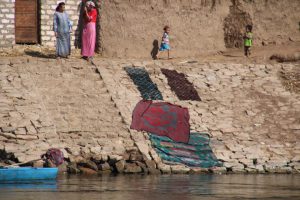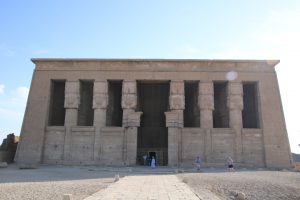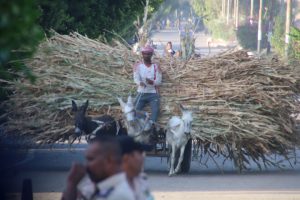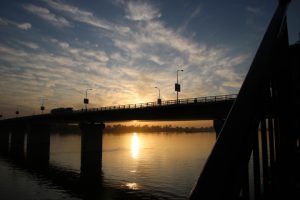We left Luxor at 7:30 a.m. this morning and slipped past the Luxor and Karnak temples as the East and West Banks were waking up. We sailed northwards to Qena. This is an important location in the events that lead to the formation of the modern Nile river system. Around 6 million years ago the climate of the Mediterranean region changed, rainfall ceased and the ancient Mediterranean Sea dried up. There was already a short river known to geologists as the Eonile River flowing northwards from the edge of the Red Sea Mountains on the east of today’s river. Earth movements along the Red Sea fault line had lifted the mountains and tilted the land to their west and northwest. Heavy rains persisted for a long time over the mountains which fed the Eonile and encouraged erosion in its upper course. Much of the water of the Eonile evaporated before reaching the dried up sea. At this time there was a river flowing south from the area around Qena. As the north flowing Eonile eroded backwards it captured the Qena river system at the latter’s first big meander. This turned the flow of the Qena River northwards and all of its tributaries became part of the Eonile and with the increased volume and a wetter climate in the Mediterranean region the Nile of today came into existence. Geographers call such a bend and change of course on a river ‘the elbow of capture’. The evidence for all of this is in the rocks and the shape of the landscape.
By lunchtime we were approaching Qena. The town sits on the huge bend referred to above and at the intersection of the Nile Valley roads and the one to the desert, Red Sea Mountains, the port of Safaga and the resort of Hurghada. Minerals, including phosphates, are extracted from the mountains and transported by rail via Qena to other parts of Egypt. We will pass under the phosphate railway bridge later today but before docking the captain took the ship up to the road bridge and checked the height of the top deck and the amount of clearance needed. The smokestack and other deck furniture had to be removed in readiness for our departure.
In the meantime we visited the nearby ancient site and temple at Dendera. This was an important administrative and religious centre around 2320 BC. It is largely intact and built at the end of the Pharaonic Period but with many Ptolemaic and Graeco-Roman additions. It was dedicated to the goddess Hathor who had medicinal skills and provided cures for the ill in the adjacent sanatorium. There is evidence of people living in the abandoned temple i.e. smoke on the roof and upper parts of pillars in the hypostyle hall.
This is the only monument in Egypt where Cleopatra is depicted albeit on an outside wall and round the back!
Departure from Qena was uneventful though the high levels of river water made it a very tight squeeze under the bridge.
We continued northwards as the sunset to dock at Nag Hammadi for part of the night. This is the only crossing point of the Nile by railway and a swing bridge parallels a road swing bridge here. We have crossed the Nile here by train on previous visits and tonight passed the railway on the Misr. Before that happened our evening meal was a barbecue on the top deck where everything had been reassembled.

















